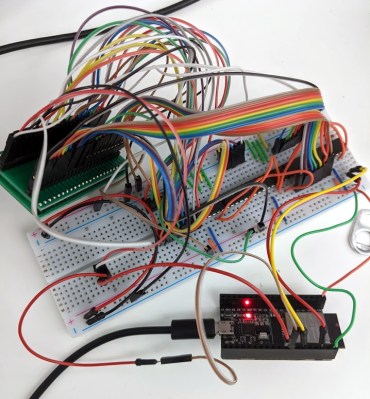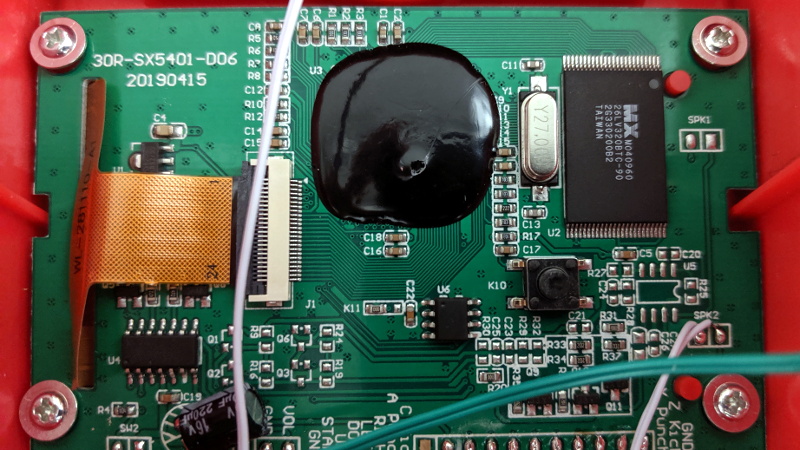You’ve probably seen a few of these miniature arcade games online or in big box retailers: for $20 USD or so you get scaled-down version of a classic arcade cabinet, perfect for a desk toy or to throw up on a shelf as part of your gaming collection. Like any good Hackaday reader, you were probably curious about what makes them tick. Thanks to [wrongbaud], we don’t have to wonder anymore.
Over the course of several blog posts, [wrongbaud] walks readers through the hardware and software used in a few of these miniature games. For example, the Rampage cabinet is using a so-called “NES on a Chip” along with a SPI flash chip to hold the ROM, while Mortal Kombat is using a Genesis emulation solution and parallel flash. It wouldn’t be interesting if they didn’t throw you a few curves now and again, right?
 But these are more than simple teardowns. Once [wrongbaud] gives an overview of the hardware, the next step is reading the respective flash storage and trying to make sense of the dumped data. These sort of games generally reuse the hardware among a number of titles, so by isolating where the game ROM is and replacing it, they can be made to play other games without hardware modification. Here, this capability is demonstrated by replacing the ROM data for Rampage with Yoshi’s Cookie. Naturally it’s one of those things that’s easier said than done, but it’s an interesting proof of concept.
But these are more than simple teardowns. Once [wrongbaud] gives an overview of the hardware, the next step is reading the respective flash storage and trying to make sense of the dumped data. These sort of games generally reuse the hardware among a number of titles, so by isolating where the game ROM is and replacing it, they can be made to play other games without hardware modification. Here, this capability is demonstrated by replacing the ROM data for Rampage with Yoshi’s Cookie. Naturally it’s one of those things that’s easier said than done, but it’s an interesting proof of concept.
The Mortal Kombat cabinet is a newer addition to the collection, so [wrongbaud] hasn’t progressed quite as far with that one. The parallel flash chip has been dumped with the help of an ESP32 and a MCP23017 I/O expander, and some Genesis ROM headers are identifiable in the data, but there’s still some sifting to be done before the firmware structure can be fully understood.
Even if you’re not in the market for a diminutive arcade experience, the information that [wrongbaud] has collected here is really phenomenal. From understanding protocols such as I2C and SPI to navigating firmware dumps with a hex editor, these posts are an invaluable resource for anyone looking to get started with reverse engineering.















I want to know what’s in those bigger ones that are getting more commodity than custom priced now, and go on sale after Christmas.
Four different, larger game cabinets for tabletop use. The screens are still pretty small. Even if all of them have all four game ROMs, their control layouts are all different, and the Space Invaders one has a horizontal only joystick. Thus making one into a 4-in-1 (or more if they use a common old console emulation and ROM swaps are possible) would require some creativity with controls.
If you mean the Arcade1up ones, they have a cheap linux soc, and can be hacked or their lvds displays simply re-purposed with a totally different computer. Many hackers drop in a pi.
Ah thanks, dunno why google wouldn’t find me this a month or two ago… https://www.reddit.com/r/Arcade1Up/comments/a02870/hack_original_board_not_just_replace_w_pietc/
To handle LVDS vid though there’s a small handful of more natural swap ins than a Pi, guess the retroPi support is why it’s popular.
Kinda see why they’re getting cheap though Allwinner A13 is like a 5 year old cheapo android tablet CPU.
Thank you for this. There is a wonderful amount of information in that series. Exactly the kind of stuff I’ve been looking for.
Glad you enjoyed it, I’m hoping to do more in the future along the same lines, probably with more focus on software RE as well!
I got the Burger Time one for $5 on clearance. They use the same board in 6 of the cabinets and you can access the others by bridging some points. I hope to add some switches like others have done, but for now there’s 4 wires poking out that just need to be connected differently for each game.
Curious as to why they aren’t emulating arcade hardware. Is it because the NOAC is stupid cheap or because its easier to license the code for the home versions?
NOACs and GOACs being stupid cheap is the right guess. Linux/Android handheld with ARM chip running MAME is usually in the $50 and up range, but the same physical shell running a NOAC is $10, and that’s with Chinese consoles ignoring inconvenient things like ‘licensing’.
i deream about change firmware in https://pl.aliexpress.com/item/1005005118739830.html 9$ console and put fuzix